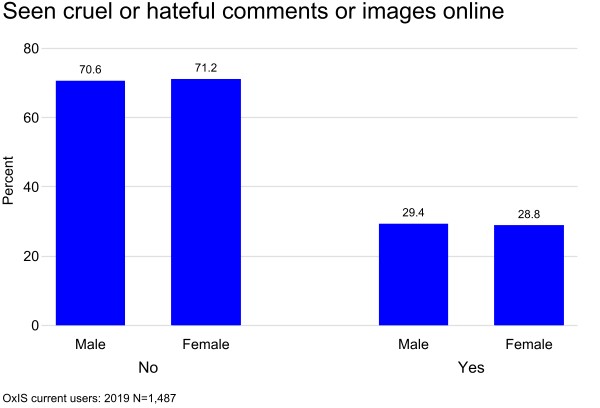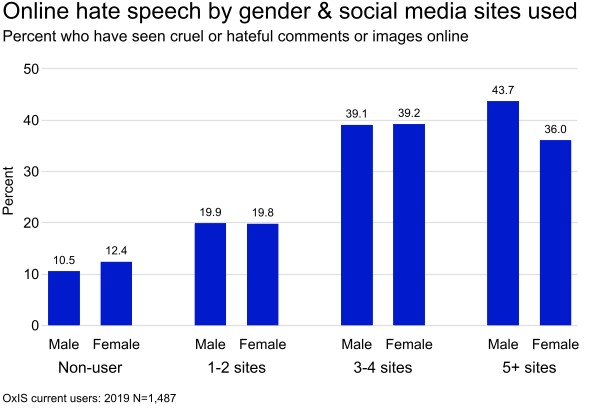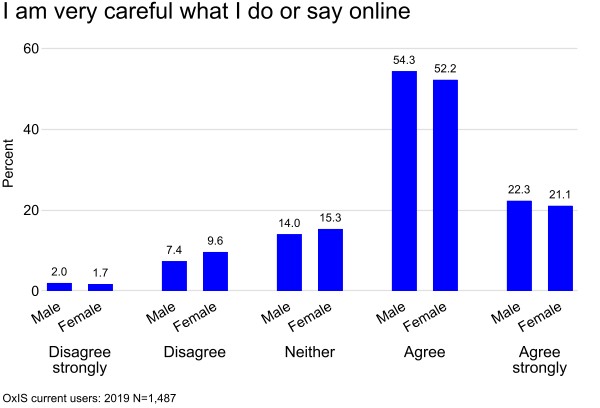Written by Grant Blank, William H. Dutton and Nico Buettner
Driven by controversies like Gamergate (e.g. Hathaway 2014), online hate speech against women has attracted increasing attention. While the prevalence of online hostility toward women is of exceptional importance, most research is anecdotal. Items from the Oxford Internet Survey (OxIS) can be used to take a closer look at gender and hate speech across the entire British population. Contrary to conventional wisdom, evidence suggests that women are not more likely than men to experience cruel or hateful speech online. In addition, there are no meaningful gender differences in experiencing online hate speech among subgroups that could be prone to greater exposure, such as social media users or younger people. Consistent with the prevalence of hate speech, women say they are not more careful than men about what they do and say online.
That women are more likely to be subject to online hate speech than men has been a theme in recent public discourse. Some subgroups of women, like journalists (Posetti et al. 2021), appear to be disproportionately more vulnerable. Other than studies of journalists’ experience, however, much of the evidence is based on anecdotes rather than systematic research. There is some systematic empirical research, but the data are not representative of a population; for example, sociologist Sarah Sobieraj wrote a recent book (2020) based on extensive interviews with 52 women. This is a valuable study of women but it doesn’t contain systematic comparisons to male experiences. These examples raise the question: Is online hate a more prevalent problem for some women, or is it disproportionately a problem for women in general? To answer that question, we look at the OxIS dataset that is a representative sample of the population of Britain. We asked “In the past year have you ever seen cruel or hateful comments or images posted online”.
Over seven out of ten respondents say “no” (71%), they have not seen cruel or hateful comments online. Moreover, the bar chart below shows that there is no difference between men and women; men’s and women’s answers are amazingly similar. The fact that over 70 percent of both men and women reported that they had not seen hate speech suggests that the problem, while a very real experience for an important segment of the population, is not part of the experience of most users. And in general, women do not report more abuse than men.
We also looked at two groups where we thought that hate speech might be more common: people on social media platforms and younger respondents. The bar chart below compares men and women by the number of social media platforms they use. The first notable result is that there is a relationship between being active on social media and witnessing hate speech: The more social media platforms a respondent is active on, the more likely they are to have seen hate speech. This is understandable since user-generated content is the most likely source of offensive speech.
The bar chart also shows the differences between men and women. For non-users of social media and for users of between one and four platforms, the difference between men and women is very small, less than two percentage points. For users with five or more profiles on social media platforms, women are about seven percentage points less likely to have seen hate speech or images. This difference is probably due to ordinary sampling error due to the relatively small number of respondents in that cell. We also examined whether gender differences in exposure to hate speech vary for users of specific social media platforms, such as Facebook, Twitter, YouTube, Snapchat, Instagram, or dating websites. Again, we find no large gender differences in online hate speech exposure. Presence on social media seems unrelated to whether women are more exposed to hate speech than men.
The next bar chart shows the relationship between age, gender and hate speech. The overall pattern is that younger people are more likely to have seen hate speech than older adults. When we look at differences between men and women, they are small, usually two percentage points or less. An exception is the age 45-54 category where women report being 11 percentage points less likely than men to have seen online hate speech. It is hard to imagine why that age group alone would be different, so this is again most likely sampling error. Overall, we find little difference between men and women across all ages.
If women are more likely to experience hate speech online, this could make them more cautious and self-conscious when they are online. We asked respondents about the extent to which they agreed or disagreed with the statement “I am very careful what I do or say online”. Most respondents agree or agree strongly, 77 percent of men and 74 percent of women. If anything, there is a slight tendency for women to be less cautious than men but three percentage points is within the margin of error of the survey. In general, men and women are equally careful about what they do or say online.
Much more analysis could be done on this topic, but these findings suggest that some emerging impressions need to be more systematically challenged. These results suggest that measures tackling hateful online content need to find solutions that do not exclusively speak to or single out the experiences of women, but look at a wider variety of factors, including the age and activity of Internet users.
* * *
Our data were collected as part of the 2019 wave of the Oxford Internet Survey (OxIS). They are a random sample of individuals living in England, Scotland and Wales. Interviews were conducted in respondents’ homes during January-March. The total sample was 1,818 respondents. The data used in this post include only the 1,487 Internet users. All the results are weighted by age, gender and region to match population proportions.
Sources cited
Hathaway, J. (2014, October 10) What is Gamergate and why? An explainer for non-Geeks. Gawker. Retrieved 6 August 2021 from http://gawker.com/what-is-gamergate-and-why-an-explainer-for-non-geeks-1642909080. The literature on Gamergate is extensive. The Wikipedia article has 274 citations!
Posetti, J., Shabbir, N., Maynard, D., Bontcheva, K., Aboulez, N. (2021) The chilling: global trends in online violence against women journalists. UNESCO. Retrieved 6 August 2021 from https://en.unesco.org/sites/default/files/the-chilling.pdf
Sobieraj, S. (2020) Credible threats: attacks against women online and the future of democracy. Oxford: Oxford University Press.




